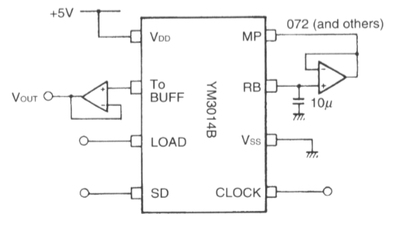First post, by s0ren
TLDR: Trying to make a YM3812 (with the YM3014B DAC) board controlled by an arduino/r-pi - sort of like this project: https://www.tindie.com/products/DhrBaksteen/o … l2-audio-board/ (works with dosbox).
I have the above linked board but I am not terribly impressed by the LM358 and LM386, even though I know that the later is the original power amp on the adlib cards. They have a rather high noise floor and do not sound very clean. I want to see if I can improve the OPL2 sound quality by using newer op-amps meant for audio.
The adlib card uses a quad RC4136 op-amp and a LM386 power amp, and the C64 sound expander uses a quad op-amp design too. From the schematics i can see that one of the op-amps perform low-pass filtering.
I am thinking of using one OPA1688 op-amp IC (a dual op-amp) in place of the quad op-amps of the adlib and sound expanders (and in place of the LM386 power amp of the adlib). Much like the YM3014B data sheet example:
OPA1688 is meant for driving headphones with an impedance down to 32 Ohm (headphone amp circuit here), but I am not sure if:
(A) Will the output volume be sufficient for line-out or small headphones?
(and will it be better if I power the op-amp with 9V instead of the arduino and raspberry pi´s 5V)
(B) Will the absence of a low-pass filter make it sound like garbage?
(are the two YM chips producing high frequency noise?)
If i manage to build this thing, then i will make the schematics public for others to make something similar AND i will make it work with the same interface as the board made by "DhrBaksteen" so that his arduino and raspberry pi software libraries will work with this one too (and thus also the dosbox support).
